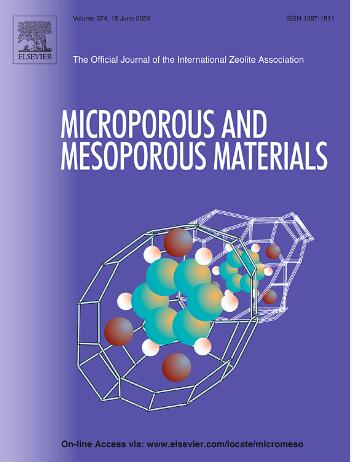Abnormal adsorption properties of the MOF CALF-20 as revealed by water and methanol vapor sorption
IF 4.8
3区 材料科学
Q1 CHEMISTRY, APPLIED
引用次数: 0
Abstract
MOF CALF-20 has been employed in industry due to its hydrophobic properties, which are conducive to CO₂ capture. Nevertheless, additional characteristics of this porous material are worthy of investigation, including its mechanical properties and flexibility. When CALF-20 is subjected to water vapor, it exhibits a slight contraction, which may be attributed to its hydrophobic nature. Conversely, when CALF-20 adsorbs methanol, it exhibits a 30 % increase in volume. Furthermore, our findings indicate that the interactions between MOFs and water or methanol are dependent on the crystalline phase. The aforementioned interactions exhibit a range of values between −37.8 and −54 kJ mol−1 in the case of water, whereas they consistently approach −53 kJ mol−1 in the case of ethanol, irrespective of the crystalline phase. This has significant implications for methanol adsorption in water-saturated CALF-20. Our findings suggest that the water confined in the pores can be pushed out by the methanol flow, whereas this phenomenon does not occur in the case of water adsorption in CALF-20 that has already been filled with methanol. These findings pave the way to improvements in Sorption-Enhanced Reaction Process technology for pure methanol production from carbon dioxide, where selective sorbents are required for shifting the methanol production equilibrium.

求助全文
约1分钟内获得全文
求助全文
来源期刊

Microporous and Mesoporous Materials
化学-材料科学:综合
CiteScore
10.70
自引率
5.80%
发文量
649
审稿时长
26 days
期刊介绍:
Microporous and Mesoporous Materials covers novel and significant aspects of porous solids classified as either microporous (pore size up to 2 nm) or mesoporous (pore size 2 to 50 nm). The porosity should have a specific impact on the material properties or application. Typical examples are zeolites and zeolite-like materials, pillared materials, clathrasils and clathrates, carbon molecular sieves, ordered mesoporous materials, organic/inorganic porous hybrid materials, or porous metal oxides. Both natural and synthetic porous materials are within the scope of the journal.
Topics which are particularly of interest include:
All aspects of natural microporous and mesoporous solids
The synthesis of crystalline or amorphous porous materials
The physico-chemical characterization of microporous and mesoporous solids, especially spectroscopic and microscopic
The modification of microporous and mesoporous solids, for example by ion exchange or solid-state reactions
All topics related to diffusion of mobile species in the pores of microporous and mesoporous materials
Adsorption (and other separation techniques) using microporous or mesoporous adsorbents
Catalysis by microporous and mesoporous materials
Host/guest interactions
Theoretical chemistry and modelling of host/guest interactions
All topics related to the application of microporous and mesoporous materials in industrial catalysis, separation technology, environmental protection, electrochemistry, membranes, sensors, optical devices, etc.
 求助内容:
求助内容: 应助结果提醒方式:
应助结果提醒方式:


